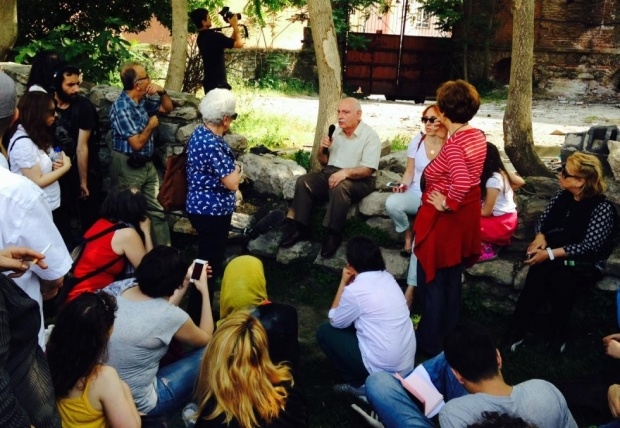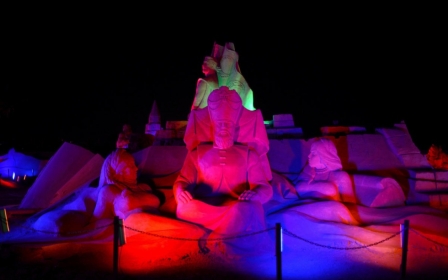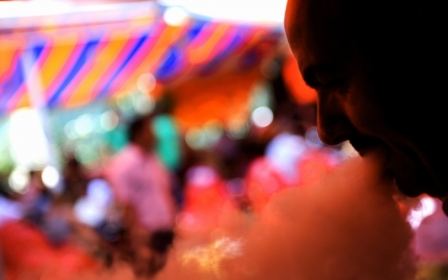Street play traces Istanbul’s historical minorities

ISTANBUL – The stories of five residents of a once-diverse Turkish neighbourhood are being re-told in a ground-breaking new play which delves into the troubled history of 20th century Istanbul.
Fifty Istanbul theatre-lovers came together to walk deserted streets of Istanbul’s eastern Fener and Balat districts last week, listening to testimonies from former Greek, Armenian and Jewish inhabitants in ‘ghost buildings’ which used to house many of the city’s former elites.
“To Where?” is directed by Berlin-based Turk Cagla Ilk and Argentina-born Armenian Silvina Der-Meguerditchian, and is a theatrical investigation which follows the migration of historic Istanbul communities.
These areas were home to minorities until the first half of the 20th century but their numbers fell after republican-era Turkey’s ‘Turkification’ policies. The 1923 population exchange between Turkey and Greece, the 1942 ‘wealth tax’ which hit non-Muslim communities and the 1955 attacks – also known as the ‘Events of 6-7 September’ – saw many minority citizens leave the country.
More than thirty people walked through some desolated streets of Fener, listening to traditional Armenian, Jewish and Greek songs.
New MEE newsletter: Jerusalem Dispatch
Sign up to get the latest insights and analysis on Israel-Palestine, alongside Turkey Unpacked and other MEE newsletters
The five-stop ‘theatre tour’ tells the story of five different residents who lived in the neighbourhood.
The first one is 75-year-old Robert Elmas. He takes the microphone and tells his story in front of his parents-in-law’s house: “There wasn’t any discrimination in this region. Turks, Jewish and Armenians; we all lived together.”
Another narrator is 68-year-old Garbis Horasanciyan. He spoke in front of an abandoned school where his father studied and is soon to make way for a hotel.
“There used to be more than 2,000 students just at the two high schools in Fener,” he says referring to the diminishing number of minority groups in the country.
Today, there are around 4,000 Greeks in Turkey while around 23,000 Jews and 60,000 Armenians live across the country, according to a report published by Minority Rights Groups International in 2007.
Then it is Agni Kucuknikolaidis’ turn; she welcomes her ‘visitors’ in a classroom where she used to study. “I studied in the school between 1975 and 1981. My mother also studied here too,” she says.
Kucuknikolaidis was born in Istanbul’s Prince Islands and as a girl commuted daily between the largest island and Fener. “We were a group of children studying in Fener and it would take us more than 12 hours every day to get to school and go back home. If you ask me now to do the same, I cannot really,” she says laughing.
As the Fener district also remains the home of the Greek Orthodox Patriarchate, the neighbourhood is very important for us, she tells the crowd.
Ersin Kalkan, a journalist, displays his garden to the audience and begins telling a love story between his older brother and a Greek girl who ended up in a convent in Greece; sadly the couple was unable to unite.
The last speaker is Hasan Acar, honorary president of the Fener-Balat-Ayvansaray Association, founded to push for the neighbourhoods’ rights against urban transformation projects. He was born in Fener but his family came to the district from north western province of Bursa around 135 years ago.
The association won a case against Istanbul’s metropolitan municipality, halting a process which campaigners claim would lead to most of the residents, unable to pay high house prices, moving to other parts of Istanbul.
All these migrations have made Fener and Balat a mysterious and sad place. Despite everything that has happened, it is still possible to find the traces of cosmopolitan culture in the neighbourhood.
The Turkish director of the project Ilk says that they have done deep interviews with all the narrators and prepared a text for each speaker.
Der-Meguerditchian, who also opened an exhibition titled ‘Memory without a Place’ recently in Istanbul, is filming the tour and is to produce it as an art documentary. “I will try to use my artistic skills to speak about traces of memories with the tool of film,” she says.
“To walk through the streets and to see such a gorgeous buildings, gorgeous past, empty… It hurts your heart,” she adds.
Ilk also mentions the importance of Fener and Balat: “Tarlabasi and Sulukule were like this… Buildings there were demolished and new ones were built. Here it is different because they are under protection of UNESCO.”
The documentary of the tour will be shown in 2015 as part of the Istanbul-based Hrant Dink Foundation’s short-film project: ‘Let’s take a look through our conscience.’
Middle East Eye delivers independent and unrivalled coverage and analysis of the Middle East, North Africa and beyond. To learn more about republishing this content and the associated fees, please fill out this form. More about MEE can be found here.




